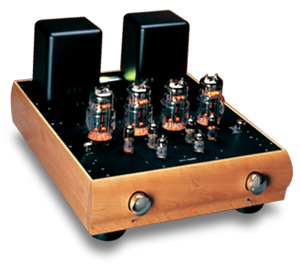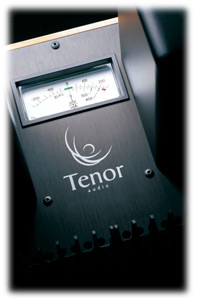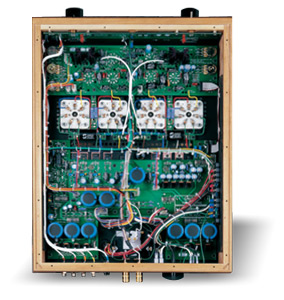![[SoundStage!]](../titles/sslogo3.gif) Home
Audio Home
Audio Equipment Review |
|||||||||||||||||||
Tenor Audio is a relatively new company based in Montreal whose amplifiers seemingly went from 0 to 100 in a fraction of an audio second. I first encountered Tenor amps at Son & Image 2001, where they made memorable music in two different rooms, both of which we named Standouts. Since then, Tenor has shown at T.H.E. Expo in Las Vegas, where they were part of a Standout room, and Montreal again, with another Standout mention. On the heels of such positive exposure, arranging a review was logical and would allow comparison of the sound heard at the various shows with that in the listening room. Tenor Audio agreed, and the review was on. The two Tenors There are two basic Tenor amplifiers, both fully balanced mono designs, that differ only in claimed power output: 15 watts versus 75 watts at 8 or 16 ohms. Both are then available in variations that do (15 Wi and 75 Wi) or do not (15 Wp 75 Wp) include input switching and volume control. The 75 Wi is the most costly amplifier in the Tenor product line at $19,900 USD per pair and thus offers the higher power output along with switching functions for up to four line-level sources and passive stepped attenuators with 24 increments for volume control. The amplifier also has a direct mode that bypasses the volume control and switching, allowing it to be used as a dedicated power amplifier, in which case you can connect to it via XLR inputs and use the amplifier fully balanced. When used as a power amp via its single-ended inputs or as an integrated amp, the 75 Wi does not retain the noise-canceling benefits of fully balanced operation. All of the Tenor Audio amplifiers are output-transformerless designs that use the uniquely shaped 6C33C-B tubes to produce their rated outputs. These Russian tubes, whose reported main use was in MIG fighter jets, are suited for OTL designs because of their low intrinsic output impedance and high durability. Two byproducts of their use in the Tenor Audio amps are high power consumption -- 730 watts for each 75 Wi amp -- and high heat production. In so many of my reviews I’ve mentioned the amount of heat that amplifiers give off, and the Tenor 75 Wi takes the lead as the amp that raised the temperature in my 12' x 24' listening room the most -- ten degrees -- not only because of the number of tubes used but also the fan in each amp. The 75 Wi is the first open-air design I’ve seen that uses a fan, which is slightly noisier than the one in my laptop, but quiet enough so that it doesn't intrude on the music.
On the front panel are the knobs for input switching and volume along with two switches for choosing the mode of operation (integrated amp versus power amp) and mute/operate status. Around back are the speaker binding posts, RCA and XLR inputs, an IEC power-cord receptacle, the on/off switch, and a fuse holder. Once you turn the amp on, a soft-start circuit slowly brings the tubes up to operating parameters, and after 60 seconds, the amp is ready to make music. When the 75 Wi is used as a power amp, the volume control and input switching are bypassed. The 75 Wi's chassis is a combination of hand-finished cherry frame and black anodized top plate. Small details like the logo etched into the undulated wooden front panel, the small handmade screwdriver included for bias adjustment, and the fact that the front-panel knobs have LEDs inserted in them at the factory (try that at home) make you realize that these amps require a great amount of workmanship and attention to detail, as they should for their cost. Each amplifier measures 17"W x 23"D x 11 1/2"H and weighs 71 pounds. System I used the Tenor amps with a bevy of high-quality equipment and wire from various companies, all of it sure to delight more than a few audiophiles. Speakers were Wilson Audio WATT/Puppy 6es and Sophias, along with a pair of Revel Studios. Preamps were the Lamm L2 Reference and Audio Research Reference Two Mk II. I used interconnects and speaker cables from Acoustic Zen (Silver Reference and Satori), Shunyata Research (Aries and Matrix), Nordost (Quattro-Fil and SPM Reference), and DH Labs (Air Matrix and Q-10). Digital sources were Mark Levinson No.39 and Audio Aero Capitole 24/192 CD players, a 47 Laboratory 4713 Flatfish transport/4705 Progression DAC/4799 Power Dumpty power supply setup, and Bel Canto DAC1.1 and DAC2 outboard DACs with either the Levinson No.39 or a Pioneer DV-525 DVD player as transport. For comparison I used my Lamm ML2 monoblocks, a single-ended variation on the tube theme. The Lamm and Tenor amps sat on sand-filled Bright Star bases, which fit both as though they were made for them. Letting them sing
But once these amps begin to make music, any thoughts of their looks melt away. The 75 Wi's sound simply oozes accuracy and life, and the amplifier presents the music in a wholly balanced and highly pleasurable way. It's open without being lean, full but without excessive warmth or any murkiness. The sound is pleasurable to the extreme and lends itself to long listening sessions, yet it is not ruined by obvious euphony or coloration. The Tenor 75 Wi immediately shows itself to be a world-class amplifier. But you want specifics, so here goes. Harmonics create the framework that gives instruments their character, and while no amp ruins this framework to the point of making a piano sound like a cello, the Tenor 75 Wi absolutely nails the harmonic structure of instruments and allows them to be completely themselves. With the Tenor amps, piano has the most correct attack and decay I've heard, while strings show consummate texture and high contrast from the noise floor of the recording, an effect more readily apparent with the 75 Wi used as an integrated amp because of very low residual noise. My favorite recording of Rhapsody in Blue is from Erich Kunzel and the Cincinnati Orchestra, with Eugene List on piano [Telarc CD-80058]. When List finally enters, the moment has high drama through the Tenor amps as the galloping notes sound utterly real and correct. I also marveled at Danilo Perez's keyboard work on Central Avenue [Impulse! IMPD-279], the follow-up recording to his Panamonk [Impulse! IMPD-190], a CD I've mentioned in more than a few reviews. The Tenor amps seemingly amplified the power and intensity of Perez's playing, even though I know it was just the amps doing their thing with the harmonic structure. At this point in time, I can honestly say that the treble of these Tenor amps is without peer for its combination of absolute clarity and lack of amusical artifacts -- the grit and hardness apparent in varying degrees in the sound of other amps by comparison. And you don't need to play only audiophile-approved fare to hear this. Throw on any old disc and see if you just don't settle into enjoying it more readily than you are used to. I finally located a favorite recording I used to own on vinyl but was not available on CD: Kate & Anna McGarrigle's Love Over and Over [Hannibal HNCD 1405]. The title tune (on which Mark Knopfler plays guitar) still sounds shrill through the Tenor amps, but it's not a cause for hitting stop and changing the disc. The highs are very clear and clean, but not bleached or lacking in character. In fact, in terms of treble purity, the Tenor amps are my new standard against which other amps will need to be measured. Down into the midrange, you will know the Tenor amps are not SET designs as they sound more neutral in this region. Yet they're just as pure here as they are in the treble. Favorites such as Greg Brown and Ani DiFranco are eminently listenable via the Tenor amps -- and how. Their voices aren't as voluptuous as they are with, say, the deHavilland Aries 845 monoblocks, a pair of which Bill Cowen reviewed in the last issue of our E-Mag. Vocals have a more truthful ring to them with the Tenor amps, perhaps because the vocals don't stand out in relation to what's happening above and below in the wide frequency range the amps reproduce.Few tube amps at any price offer bass that approaches the state of the art, and the Tenor amps are no exceptions to this. The amps play low enough and with enough impact to make their presence known on any piece of music, and there is a nimble, energetic demeanor to the low end that makes plucked bass, for instance, sound very coherent and defined. But the bass is a tad light and fuzzy at its absolute extremes. When the low end of a recording really exerts itself, the 75 Wi sounds sort of like a SET amp when it runs out of power, but the rest of the spectrum keeps up at world-class pace. Spain's The Blue Moods of Spain [Restless 772910-2] shows this in obvious fashion, as the very prominent bass lines are a bit less weighty and present through the Tenor amps. Yet, I still enjoyed this recording immensely with the amps in my system, as the bass is still easily recognizable for what it is: deep, weighty, and atmospheric. You won't be considering these amps, or any tube amps, if you're a bass freak, but any perceived limitations down low are more than made up for everywhere else. In regard to how to use these amps, integrated versus strict power amp, it seems silly to me to pay more for the switching and volume control, which is a $1000 premium, and not use it. Overall system noise is lower, and you can perhaps more easily justify the stiff price of the amps by not having to purchase a preamp. In terms of sound, the 75 Wi is more intimate as an integrated amp, and depending on your system and tastes, this may put you miles ahead sonically. I preferred the amps this way with the WATT/Puppy 6 speakers and, to a slightly lesser extent, the Sophias too. I also loved having this functionality for reviewing, as I could listen to a source through the preamp and then through the amps only. A very satisfying system was the Tenor amps, the Wilson WATT/Puppy 6 speakers, and the 47 Laboratory transport/DAC/power supply combination. I spent more than a couple of nights pulling out CD after CD to revel in how they sounded on this combination of gear. Comparison I'm sure some of you are just about sick of having me trudge my Lamm ML2s out for every comparison, but in this case, they really are just about the best amps for this duty. Like the Tenors, the Lamms use 6C33C output tubes and cost a bundle (in fact, almost 50% more than the Tenors). Unlike the Tenor amps, the Lamms are a SET design and thus output far less power, a mere 18 watts. Both of these amps are tube titans, but how do their sonic characters compare? Very well, with some differences, of course. Both are very complete and balanced sonically, but the Lamms offer a touch more image solidity, perhaps due to their greater leading-edge definition. Brass is brassier through the Lamm amps, which may or may not be a good thing depending on the rest of your system and tastes. The bass of the Lamm amps is weightier and more physical than that of the Tenors, and it's able to capture more of the low-frequency ambient information on a recording (what the Wilson WATCH Dog subwoofer does in spades). Soundstaging is always a function of a recording's ability to show it, and while some amps do it better than others, most high-quality amps these days present a credible soundstage, with some differences among them. The Tenor amps have a more forward signature and larger soundstage than the Lamms -- albeit one that was slightly less deep but also wider. The Tenor amps brought mono recordings to life, giving the performers a larger presence in the soundstage. The Lamms sound more intimate and close-up, more like the Tenor amps used sans preamp. I could go on and on, but you get the point: these are differences, not the sort of things that will make you believe that one or the other amp is necessarily better. Both of these amps reiterate what high-end audio is about: inspired design, conversation-piece looks (though the Lamms often earn this by their simple black-boxiness) and sound that reaffirms how involving reproduced music can be. Summing up Is it clear that I treasured my time with the Tenor 75 Wi amplifiers? Their handling of harmonics grabbed my attention from the very beginning, and their clear and addictive treble set a standard that I've not heard equaled. Add in their stunning looks and the fact that you can use them either as power or integrated amps and you have a special audio product -- a mono tube amplifier that belongs to the exclusive group of amps that can claim to be the very best available. My reference Lamm ML2s belong too, as do, I suspect, the Audio Research Reference 600 Mk II and Reference 300 Mk II, the Atma-Sphere MA-2 Mk II.3, and Joule Electra VZN-160 Mk III Grand Marquis -- all very different designs to be sure. That a product from a relatively new company can make its way into this grouping is very impressive indeed, but not as impressive as the sound of these gorgeous amps. What more can I say? Seek out a pair, but have your checkbook ready. ...Marc Mickelson
|
|||||||||||||||||||
|
|||||||||||||||||||
![[SoundStage!]](../titles/sslogo3.gif) All
Contents All
ContentsCopyright © 2002 SoundStage! All Rights Reserved |



 In addition to the four 6C33C-B output tubes, each 75 Wi
uses pairs of 12AX7As, 6H6Ps, and 6H30Ps for input duty. Adjusting the amp's bias and DC
balance is a snap. In between the two towers on the rear of the amp (the output-stage and
driver-stage power transformers) is a meter, while off to the right on the top plate is a
knob for selecting the tube whose bias you want to adjust or DC balance. On both sides of
the amp's top plate are potentiometers for the tubes, while on the left is a knob for
adjusting DC balance. You simply put the amp in mute (the meter is lighted once the amp is
switched to mute, a nice touch), make the adjustments, then resume playing music. The bias
and DC balance will drift a bit over time, but veteran tube-amp users know this is fairly
common and not worth the time for constant readjustment. But if you love this kind of
tweaking, Tenor Audio makes doing so easy.
In addition to the four 6C33C-B output tubes, each 75 Wi
uses pairs of 12AX7As, 6H6Ps, and 6H30Ps for input duty. Adjusting the amp's bias and DC
balance is a snap. In between the two towers on the rear of the amp (the output-stage and
driver-stage power transformers) is a meter, while off to the right on the top plate is a
knob for selecting the tube whose bias you want to adjust or DC balance. On both sides of
the amp's top plate are potentiometers for the tubes, while on the left is a knob for
adjusting DC balance. You simply put the amp in mute (the meter is lighted once the amp is
switched to mute, a nice touch), make the adjustments, then resume playing music. The bias
and DC balance will drift a bit over time, but veteran tube-amp users know this is fairly
common and not worth the time for constant readjustment. But if you love this kind of
tweaking, Tenor Audio makes doing so easy. I used the pair of Tenor 75 Wi amps first as power amps,
both via single-ended and balanced inputs, then as integrated amps. While the overall
sonic signature remained easily identifiable, I found that there were a few differences,
which I'll discuss below. However, before these amps make a sound, they impress with their
dramatic beauty, all those tubes only enhancing the wood chassis and nickel-plated knobs
on the front. If you like your audio gear to cause a stir even when it's off, these are
the amps for you.
I used the pair of Tenor 75 Wi amps first as power amps,
both via single-ended and balanced inputs, then as integrated amps. While the overall
sonic signature remained easily identifiable, I found that there were a few differences,
which I'll discuss below. However, before these amps make a sound, they impress with their
dramatic beauty, all those tubes only enhancing the wood chassis and nickel-plated knobs
on the front. If you like your audio gear to cause a stir even when it's off, these are
the amps for you.